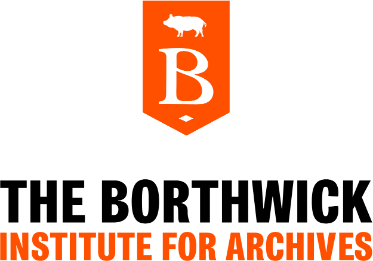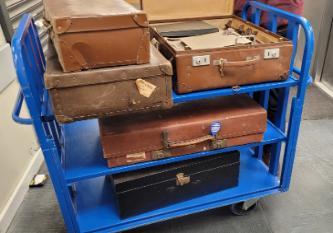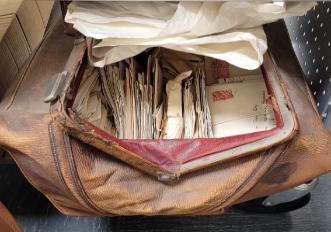Borthwick Newsletter - October 2023
Posted on 28 September 2023
October in the Archives - delve into our catalogues with this month’s featured description.
Printed notice to members of The Society of Friends in favour of the election of William Wilberforce as Member of Parliament for York 27 October 1806. Written by William Tuke, Thomas Priestman and Lindley Murray, this explains why, as Quakers, they should, unusually, be actively involved in this election, due to Wilberforce's stance on Africa [The Retreat Archive, RET/8/9/2, digitised image available online]
What’s New?
It’s the start of a new academic year here at the university and campus is becoming busy again after a quiet summer. The return of students means the return of teaching, and staff have been busy selecting and preparing archives for classes and student visits. This year that includes a new Public History undergraduate module as well as the return of our annual palaeography and Latin courses which showcase a range of mediaeval and early modern documents from across our collections.

With the new academic year comes a new logo for the Borthwick too. The Borthwick has long been associated with the colour orange and, of course, St Anthony’s Pig. The Borthwick Pig has its origins in a sketch made by our first Director, Canon John Stanley Purvis, of a decoration in the roof of our first home, St Anthony’s Hall in York. We’re pleased to say our new logo keeps the pig, and the orange, but brings them both a little more up to date. You’ll be seeing the change across our websites and social media from this week onwards!
New Accessions
In September we received a really exciting accession, the archive of the Terry family of York. Today, the name Terry may conjure up images of the delicious Terry’s Chocolate Orange, but in its earliest days the business was better known for its candied peel, cough lozenges and sweets, than its chocolates. Joseph Terry started out as a chemist and when he married into the existing Berry confectionery business in York in 1823 he used his chemistry skills to develop new products that were sold at its shop in St Helen’s Square. For a very short while the business had the rather memorable name of Terry & Berry, but from 1828 it was known as Joseph Terry and Company, with Terry as the sole owner. The business continued to grow over the course of the nineteenth century - and to expand its range of chocolate products, resulting in some of the famous names we know today. A Terry’s Chocolate Apple was launched in 1926, followed by the more popular Terry’s Chocolate Orange in 1931, and then Terry’s All Gold boxed chocolates in 1932. At the height of their success the family’s Chocolate Works factory in York employed some 2,500 people and the surviving business archive has been at the Borthwick since 2005.


The history of the Terry family, however, was rather less well known. In 1927 Noel and Kathleen Terry built Goddards, an Arts and Crafts home close to York Racecourse which is now run by the National Trust as a popular local tourist attraction. The house alone can, and has, revealed much about the family, but the survival of the Terrys’ own letters, diaries and photographs promise to reveal much more. From the earliest days of the Terry’s business to the Second World War and beyond, the archive tells the story of a leading York family from the 1840s to the 1990s in their own words and we are thrilled to have the opportunity to make it available to the public for the first time. Watch this space for more details!
In addition to our Terrys accession, we’ve taken a number of additions to existing archives this month. Three of these are additions to the archive of Michael Young, a York graduate and businessman who played a key role in the negotiations between the South African government and the African National Congress (ANC) which contributed to the release of Nelson Mandela and the end of the Apartheid regime. The newest additions largely concern Young’s time at the University of York and his wider work for the Conservative and Liberal Democrat parties. We’ve also added an autograph book to the Ernest Maxin Archive covering the period 1935 to c 1940, and several additions to the University of York Archive, including original lecture notes from the Department of Computation c 1970 and health and safety and working time notices from c 1967, both providing valuable insight into the university’s earliest years.
Cataloguing
Number of archival descriptions on Borthcat on 1st October 2023: 130,320
In September we added the complete catalogue of the parish archive of Wheldrake to Borthcat. At 35 boxes, Wheldrake is one of our larger parish archives and, as is evident from the catalogue, one that’s particularly rich in content. Although the present parish church of St Helen was largely rebuilt in the late eighteenth century, the earliest record of a church at Wheldrake can be found in Domesday and a parsonage house was mentioned in 1535. The first surviving parish register of baptisms, marriages and burials begins in 1603 but from the eighteenth century onwards there is a wealth of additional material which paints a vivid picture of community life. The accounts and assessments of the parish Overseers of the Poor survive from 1704, the churchwardens’ accounts from 1740, and the constables’ accounts from 1745. There are charity deeds and accounts from 1699 onwards, attesting to those who left money and property to the parish, often for the upkeep of the church or the good of the poor; and there are records relating to Wheldrake parish school from 1828, including building and administrative records.
However it is often the more unusual records that stand out and the archive contains plenty of these too. Perhaps you want to find out more about the Wheldrake and Langwith Association for the Prosecution of Felons, 1816-1864? Or the Wenlock Foresters’ Friendly Society rules for 1906? The archive also includes special Forms of Service to be used in wartime, and all of the planning papers for the parish Summer Fete in the late 1980s. One of the most exciting things about cataloguing parish archives is that you never quite know what you’re going to find and Wheldrake is a perfect example of just how intriguing and varied those discoveries can be.
Borthwick Out and About
There’s been something of an emphasis on all things Rowntree in September. Our Collections Information Archivist spoke at the opening reception of the Enterprising York conference on the 15th on the value of the newly catalogued Joseph Rowntree Reform Trust Archive for teaching and research. The Rowntree Society have also published two blogs by their recent interns Sacha and Suzannah. Suzannah visited us to research the 1920s travel diaries of Jean Rowntree, a granddaughter of Quaker confectioner Joseph Rowntree and a fascinating woman in her own right, while Sacha looked at our Michael Rowntree archives, in particular those relating to his lifelong passion for birdwatching and how his interest in nature remains relevant today.
 - Copy-756x926.jpg)
Looking forward to October, The Rowntree Society are also hosting a talk by Dr Emma Robertson on Tuesday 24th entitled, ‘From Kit Kats to Colonialism: A Rowntree Research Journey’. Dr Robertson is the author of Chocolate, Women and Empire (2009), which drew on the extensive Rowntree company and family archives at the Borthwick. Her new talk will be available on zoom and is free to attend, though tickets must be pre-booked.
In other news, Dr Valerie Hitchman at the University of Kent has produced a national database of all surviving pre-1850 churchwardens’ accounts which includes records from the Borthwick’s own parish archives. Churchwardens are lay officials who have charge of the routine running and maintenance of parish churches and other parish buildings. Before the Elizabethan Poor Laws were enacted at the end of the sixteenth century they also had responsibility for distributing aid to the parish poor. As such, their records are a rich source of information about church, parish and community life, from the religious changes with shaped and reshaped the physical appearance of the church to the names and personal details of those who worked and worshipped in it.
Last, but certainly not least, you can still listen to University Art Curator Helena Cox talking on BBC Radio York about the new LongBoilogy Art Trail around campus, created in memory of Long Boi, the distinctive and well loved university duck who sadly died earlier this year. The trail is open to all and you can listen to the section via BBC Sounds (skip to 2:51:37 in the broadcast).
Archive of the Month: Ernest Maxin Archive
What is it? The archive of BBC television producer Ernest Maxin.
Where can I find it? A full box list of the archive is available on our online catalogue Borthcat.
Why is it Archive of the Month? The Ernest Maxin Archive is one of the latest additions to the Borthwick’s Samuel Storey Writing and Performance Collection, which also boasts the archives of playwrights Alan Ayckbourn and Julia Pascal, comedy writers Laurence Marks and Maurice Gran, director Cordelia Monsey, and comedian and entertainer Frankie Howerd, amongst others. Born to a Jewish family in London in 1923, Ernest Maxin entered the entertainment world at the age of only six and later worked as a dancer at the famous Windmill Theatre in Piccadilly during the Second World War. He was also a talented boxer and did his National Service with the RAF. His television career began in 1952 when he joined the BBC and he went to produce the Morecambe and Wise Show at the height of the duo’s fame in the 1970s. Most notably Maxin choreographed the famous ‘breakfast routine’ (which can be viewed on YouTube) and the parody of Singin’ in the Rain for the pair and the latter was seen by Hollywood star Gene Kelly who liked it so much he met Maxin and gave him a signed photo.
The photograph forms part of the archive, which also includes scripts, story outlines, production notes, correspondence, audio and video cassettes, and promotional materials relating to an enormous range of television, film and theatre projects from 1957-2008. Some of these, like the Morecambe and Wise show, are well known, but others never made it past the planning stages, providing a real insider view of the entertainment industry and what it took to get a project to stage or screen. Placed alongside the archives of comedian and scriptwriter Barry Took, Marks and Gran, and Frankie Howerd, Maxin’s archive introduces us to the world of popular entertainment in the 1960s, 70s and 80s, and the men who held power in it.
We’ll be back with more news from the archives in November!


